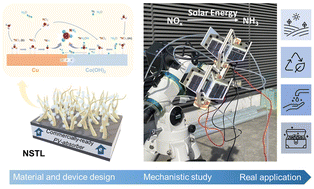Converting solar energy into chemicals and fuels through photoelectrocatalytic (PEC) process is challenging but holds significant potential for advancing sustainable development. Here we introduce an innovative system to realize solar-driven NH3 production from waste nitrate by nano-structured top layer (NSTL) hybrid catalysts modified commercial Si absorber, to bridge the gap from fundamental understanding to the process engineering. Specifically, we employ a rationally designed Si/Cu-NSTL/Co(OH)2 ternary photocathode featuring a Schottky barrier contact enabling optimized photo-carrier transport pathways and a beneficial co-adsorption configuration of *NO3–H2O moieties. This photocathode exhibits the best-known performance in the literature for the PEC conversion of NO3 to NH3, boasting an onset potential of approximately 1 VRHE and a remarkable faradaic efficiency of nearly 100%. Building upon these findings, we develop the first large-scale unbiased PEC device (an artificial leaf) capable of simultaneously producing NH3 and valorizing biomass, achieving a solar utilization efficiency of approximately 4%. Its scalability and practical feasibility have been further validated through rigorous outdoor testing with an assembled tandem device array. The process techno-economic assessment shows compelling economic viability of this technology across diverse application scenarios in NH3 production, resulting in substantial savings of fossil fuel and a reduction of CO2 emissions. We anticipate that this work will serve as a valuable resource for the design of next-generation photoelectrodes and devices, bringing us one step closer to realizing standalone solar-to-sustainable chemical applications.
